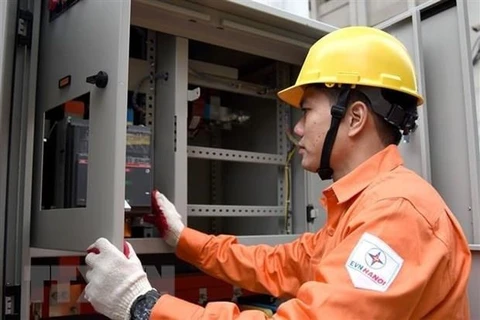Hanoi (VNA) - In an effort to take the lead in the post-pandemic economic recovery and development, Hanoi has stepped up investment in the development of industrial clusters.
The move aims to attract more domestic and foreign investment, especially FDI.
According to figures from the municipal Department of Industry and Trade, the capital is now home to 70 industrial clusters in 17 towns and districts on a total area of 1,686 ha.
The clusters have attracted about 3,864 production and business facilities, generated jobs for more than 60,000 workers, and contributed around 1.1 trillion VND (47.6 million USD) to budget funds.
In the long term, Hanoi needs a network of industrial clusters that can support it in building modern, competitive, and environmentally-friendly industry.
It approved a plan in 2018 on industrial cluster development to 2020 and vision towards 2030, covering 159 industrial clusters with a combined area of over 3,200 ha.
This is the legal foundation for the city to build and expand its industrial clusters, thus forming a network.
Hanoi is now speeding up construction of technical infrastructure at 19 clusters on a total area of 22 ha, which was approved in 2018-2019.
There remain certain limitations in the effort, however, as this is the first time the capital has realised Government Decree No 68/2017/ND-CP on industrial cluster management and development, dated May 25, 2017.
Meanwhile, the majority of the 25 clusters planned for this year are being built.
Tran Thi Phuong Lan, deputy director of the department, said it will continue to review industrial clusters in the city, call for more investors, and submit projects to the municipal People’s Committee for approval.
As of September, the department had coordinated with other departments, agencies and district People’s Committees to assess nine clusters.
The assessments revealed difficulties and bottlenecks, mostly relating to policies on land and site clearance and requiring drastic direction from relevant departments and agencies as well as the involvement of district People’s Committees and businesses.
According to the city People’s Committee, apart from investment incentives, it is also necessary to push ahead with building technical infrastructure in industrial clusters.
Hanoi has therefore issued a document in this regard, under which it prioritises clean, automated, and environmentally-friendly technologies, while moving production facilities and craft villages away from residential areas to concentrated production areas.
With such efforts, the department expects that targets set for 2020 and the 2021-2025 period will be reached./.
The move aims to attract more domestic and foreign investment, especially FDI.
According to figures from the municipal Department of Industry and Trade, the capital is now home to 70 industrial clusters in 17 towns and districts on a total area of 1,686 ha.
The clusters have attracted about 3,864 production and business facilities, generated jobs for more than 60,000 workers, and contributed around 1.1 trillion VND (47.6 million USD) to budget funds.
In the long term, Hanoi needs a network of industrial clusters that can support it in building modern, competitive, and environmentally-friendly industry.
It approved a plan in 2018 on industrial cluster development to 2020 and vision towards 2030, covering 159 industrial clusters with a combined area of over 3,200 ha.
This is the legal foundation for the city to build and expand its industrial clusters, thus forming a network.
Hanoi is now speeding up construction of technical infrastructure at 19 clusters on a total area of 22 ha, which was approved in 2018-2019.
There remain certain limitations in the effort, however, as this is the first time the capital has realised Government Decree No 68/2017/ND-CP on industrial cluster management and development, dated May 25, 2017.
Meanwhile, the majority of the 25 clusters planned for this year are being built.
Tran Thi Phuong Lan, deputy director of the department, said it will continue to review industrial clusters in the city, call for more investors, and submit projects to the municipal People’s Committee for approval.
As of September, the department had coordinated with other departments, agencies and district People’s Committees to assess nine clusters.
The assessments revealed difficulties and bottlenecks, mostly relating to policies on land and site clearance and requiring drastic direction from relevant departments and agencies as well as the involvement of district People’s Committees and businesses.
According to the city People’s Committee, apart from investment incentives, it is also necessary to push ahead with building technical infrastructure in industrial clusters.
Hanoi has therefore issued a document in this regard, under which it prioritises clean, automated, and environmentally-friendly technologies, while moving production facilities and craft villages away from residential areas to concentrated production areas.
With such efforts, the department expects that targets set for 2020 and the 2021-2025 period will be reached./.
VNA

























